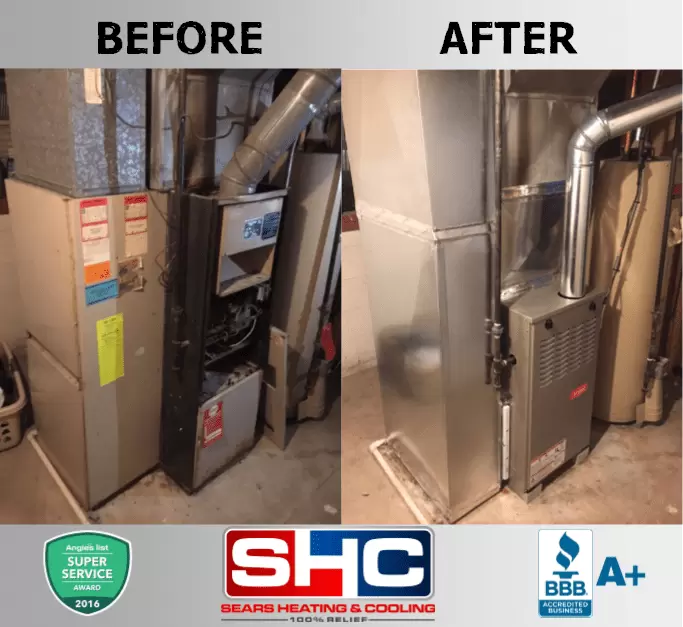
Stay Warm This Winter: How to Identify and Seal Drafts in Your Ohio Home
Winter in Ohio can be harsh, and nothing makes a home feel more uncomfortable than cold drafts sneaking in through hidden gaps and cracks. Not only do these drafts create chilly spots in your home, but they can also lead to higher energy bills as your heating system works overtime to compensate leading to possible furnace repairs. Fortunately, identifying and sealing drafts is a simple yet effective way to improve your home’s heating efficiency and overall comfort. Here’s how to get started.
Step 1: Identify Drafty Areas
Before you can seal drafts, you need to find them. Here are some simple methods to locate air leaks in your home:
- The Hand Test – On a cold day, run your hand around windows, doors, electrical outlets, and baseboards. If you feel cold air, there’s a draft.
- The Candle Test – Light a candle and hold it near suspected leak areas. If the flame flickers or moves significantly, air is entering your home.
- Use an Infrared Thermometer – These devices can detect cold spots along walls, floors, and ceilings, pinpointing areas where heat is escaping.
- Check for Visible Gaps – Inspect windows, doors, and foundation cracks where light or cold air may be coming through.
- Listen for Whistling Sounds – On a windy day, drafts can sometimes be heard as faint whistling or rushing air around doors and windows.
Step 2: Seal Air Leaks Around Windows and Doors
Windows and doors are some of the biggest culprits when it comes to heat loss. Here are some effective ways to seal them:
- Weatherstripping: Install adhesive-backed weatherstripping around doors and operable windows to create a tight seal.
- Caulking: Use caulk to seal small gaps and cracks around stationary windows, door frames, and baseboards.
- Draft Stoppers: Use or create draft stoppers (also known as door snakes) to block airflow at the bottom of doors.
- Storm Windows: If your home has older windows, consider installing storm windows to provide an extra layer of insulation.
- Window Insulation Kits: Clear plastic window insulation kits can help trap heat inside while still allowing natural light in.
- Door Sweeps: Install door sweeps on exterior doors to block drafts from creeping in at the bottom.
Step 3: Insulate Electrical Outlets and Switches
Believe it or not, air leaks can occur through electrical outlets and switches, especially on exterior walls. Here’s how to fix them:
- Foam Gaskets: Install foam gaskets behind outlet and switch plates to reduce drafts.
- Outlet Covers: Use childproof outlet covers to block airflow from unused outlets.
- Seal Wire Openings: Apply caulk or spray foam to seal openings where electrical wires enter walls.
Step 4: Address Drafts from the Attic and Basement
Many homes lose a significant amount of heat through the attic and basement. Tackling these areas will make a big difference in energy efficiency.
- Attic Access Points: If you have an attic door or pull-down stairs, install weatherstripping and insulation to prevent warm air from escaping.
- Insulate Attic Hatches: Add insulation or a specialized attic tent to prevent heat loss.
- Seal Basement Gaps: Check for gaps around pipes, vents, and foundation walls, sealing them with expanding foam or caulk.
- Chimneys and Fireplaces: Close the damper when the fireplace is not in use, and consider adding a chimney balloon or cap to prevent cold air from coming down the chimney.
- Crawl Space Sealing: Use vapor barriers and insulation to reduce drafts from crawl spaces beneath your home.
Step 5: Upgrade Insulation for Long-Term Efficiency
Even after sealing drafts, poor insulation can contribute to heat loss. Consider upgrading insulation in key areas such as:
- Walls and Ceilings: Adding fiberglass, foam, or cellulose insulation can improve heat retention.
- Flooring: Insulating floors above unheated spaces, such as garages or crawl spaces, helps maintain warmth.
- Ductwork: Leaky ductwork can lead to heat loss before warm air reaches your living spaces. Seal and insulate ducts for better efficiency.
- Water Heater and Pipes: Wrap insulation around exposed pipes and your water heater to reduce heat loss.
Bonus Tips to Enhance Heating Efficiency
Aside from sealing drafts and improving insulation, there are additional steps you can take to maximize warmth and reduce energy costs:
- Use Heavy Curtains: Thermal or blackout curtains help trap heat inside during the winter months.
- Adjust Ceiling Fans: Set ceiling fans to rotate clockwise on a low setting to push warm air downward.
- Program Your Thermostat: Lowering the temperature by a few degrees when you’re asleep or away can lead to significant energy savings.
- Keep Vents Clear: Ensure that furniture and rugs are not blocking heating vents so that warm air can circulate effectively.
- Maintain Your HVAC System: Regular maintenance, such as changing air filters and scheduling a furnace tune-up, ensures your heating system runs efficiently.
- Seal HVAC Registers: Use weatherstripping around duct registers to minimize air leakage.
- Cook More at Home: Using your oven during winter helps add warmth to your home naturally.
- Layer Up: Wearing warm clothing and using cozy blankets can reduce the need to crank up the thermostat.
Stay Warm with Sears Heating & Cooling
Sealing drafts and improving insulation are great ways to keep your home warm and energy-efficient. However, your home’s heating system plays a crucial role in maintaining comfort during the harsh Ohio winter. If you need expert advice or assistance with HVAC maintenance, contact Sears Heating & Cooling. Our team specializes in HVAC trouble shooting, heating system maintenance, furnace repair, and home energy efficiency solutions.
Don’t let drafts and high energy bills keep you uncomfortable this winter. Call Sears Heating & Cooling today 614-475-1800 to schedule a professional energy assessment and furnace tune-up!

















